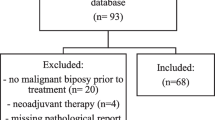Abstract
Background
We examined the current status and diagnostic accuracy of currently available techniques for tumor staging and assessed treatment outcomes in patients with superficial esophageal cancer who received esophaguspreserving therapy, such as endoscopic mucosal resection (EMR) alone or combined with chemoradiotherapy (CRT).
Methods
In 274 patients with superficial esophageal cancer, we examined the depth of tumor invasion and the degree of lymph node metastasis by means of endoscopy, magnifying endoscopy, endoscopic ultrasonography (EUS), computed tomography (CT), and cervical and abdominal ultrasonography (US). We compared treatment outcomes among treatment groups according to the depth of tumor invasion.
Results
The rates of correctly diagnosing the depth of tumor invasion were 89.6% on conventional endoscopy, 90.1% on magnifying endoscopy, and 85% on scanning with a high-frequency miniature ultrasonic probe (miniature US probe). Diagnostic accuracy for the m3 or sm1 cancers was poor. Magnifying endoscopy allowed invasion to be more precisely estimated, thereby improving diagnostic accuracy. However, lesions that maintained their surface structure despite deep invasion were misdiagnosed on magnifying endoscopy. A miniature US probe was useful for the assessment of such lesions. The diagnostic accuracy of EUS for lymph node metastasis was 83%, with a sensitivity of 76%. The sensitivity of CT was 29%, and that of cervical and abdominal US was 17%. Patients with m1 or m2 cancer had good outcomes after esophagus-preserving therapy. Although there were no significant differences in survival rates, many patients with sm2 or sm3 cancer who received CRT died of their disease. Nodal recurrence was diagnosed by EUS. In patients who received CRT, the time to the detection of recurrence was slightly prolonged.
Conclusions
Long-term follow-up at regular intervals is essential in patients with m3 or sm esophageal cancers who receive esophagus-preserving treatment. At present, EUS is the most reliable technique for the diagnosis of lymph node metastasis and is therefore essential for pretreatment evaluation as well as for follow-up. Earlier detection of recurrence at a level that would potentially salvage treatment remains a topic for future research.
Similar content being viewed by others
References
Makuuchi H, Shimada H, Chino O, Tanaka Y, Kise Y, Nishi T, et al. Long term prognosis of m3, sm1 cancer of the esophagus — comparison between EMR and radical surgery cases. Stomach Intest 2002;37:53–63 (in Japanese with English abstract).
Shimada H, Makuuchi H, Chino O, Nishi T, Kise Y, Hanashi T, et al. Clinical outcome of surgical treatment for m3, sm esophageal cancer: a point of view on three-field lymph node dissection. Stomach Intest 2006;41:1429–1440 (in Japanese with English abstract).
Arima M, Tada M, Arima H, Tanaka Y. Accuracy of EUS for estimating the depth of tumor invasion and for diagnosing lymph node metastasis and recurrence in patients with m3 and sm esophageal carcinomas. Stomach Intest 2006;41:1386–1396 (in Japanese with English abstract).
Muro K, Arai T, Hamanaka H. Chemoradiotherapy for superficial (sm2/sm3) esophageal cancer: chemoradiotherapy for clinical Stage I esophageal cancer. Stomach Intest 2002;37:1305–1314 (in Japanese with English abstract).
Momma K, Yoshida M, Fujiwara J, Egashira H, Kuruma S, Egawa H, et al. Treatment strategy of m3 and sm1 esophageal cancer based on the clinical results of endoscopic resection associated with adjuvant treatments. Stomach Intest 2006;41:1447–1458 (in Japanese with English abstract).
Arima M, Tada M. Early diagnosis of local recurrence and lymph node metastasis after EMR for m3 and sm1 esophageal cancer. Endosc Dig 2003;15:389–395 (in Japanese with English abstract).
Momma K, Yoshida M, Yamada Y, Arakawa T, Amemiya K, Kozawa H, et al. Present status of endoscopic evaluation of m3 and sm1 esophageal cancer. Stomach Intest 2002;37:33–46 (in Japanese with English abstract).
Arima M, Tada M. Endoscopic diagnosis of early esophageal cancer. Endosc Dig 2005;17:1531–1534 (in Japanese with English abstract).
Arima M, Tada M, Arima H. Evaluation of microvascular patterns of superficial esophageal cancers by magnifying endoscopy. Esophagus 4;2005:191–197.
Arima M, Arima H, Tada M. Diagnosis for depth of cancer invasion of superficial esophageal cancers by microvascular pattern using magnifying endoscopy. Endosc Dig 2005;17:2076–2083 (in Japanese with English abstract).
Yamanaka T. JGES consensus meeting report in DDW-Japan 2000, Kobe: interpretation of the layered structure of gastrointestinal wall with endoscopic ultrasonography. Dig Endosc 2002;14:39–40.
Arima M, Arima H, Tada M. Clinical significance of endoscopic ultrasonography versus magnifying endoscopy for estimating the depth of tumor invasion in superficial esophageal cancer. Stomach Intest 2006;41:183–196 (in Japanese with English abstract).
Arima M, Tada M, Ohkura Y. Diagnosis of depth of invasion and lymph node metastasis of esophageal cancer using endoscopic ultrasonograpy. Endosc Dig 2002;14:573–581 (in Japanese with English abstract).
Murata Y. The evaluation of endoscopic ultrasonography and conventional ultrasonography for staging in superficial esophageal cancer-assessment by histological findings and clinical course. Jpn J Gastroenterol Surg 1989;22:195–204 (in Japanese with English abstract).
Arima M, Tada M. Endosonographic assessment of the depth of tumor invasion by superficial esophageal cancer, using a highfrequency miniature US probe: difficulties in interpretation and misleading factors. Stomach Intest 2004;39:901–913 (in Japanese with English abstract).
Sakurada A, Imai Y, Takahara T, Nozaki M, Kato Y, Makuuchi H. Improved detection of lymph node metastasis in esophageal cancer: evaluation by computed tomography and magnetic resonance imaging: focus on the diffusion weighted image. Stomach Intest 2006;41:215–223 (in Japanese with English abstract).
Kato H, Fukai Y, Kuwano H. Diagnosis of metastatic lymph node in esophageal cancer. Stomach Intest 2002;41:1397–1405 (in Japanese with English abstract).
Arima M, Tada M. Endoscopic ultrasound-guided fine needle aspiration biopsy in esophageal and mediastinal diseases: clinical indications and results. Dig Endosc 2003;15:93–99.
Author information
Authors and Affiliations
Corresponding author
Additional information
Review articles on this topic also appeared in the previous issue (Volume 4 Number 3). An editorial related to this article is available at http://dx.doi.org/10.1007/s10388-007-0119-7.
Rights and permissions
About this article
Cite this article
Arima, M., Arima, H., Tada, M. et al. Diagnostic accuracy of tumor staging and treatment outcomes in patients with superficial esophageal cancer. Esophagus 4, 145–153 (2007). https://doi.org/10.1007/s10388-007-0136-6
Received:
Published:
Issue Date:
DOI: https://doi.org/10.1007/s10388-007-0136-6




